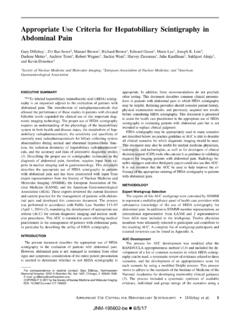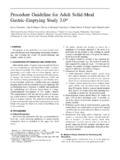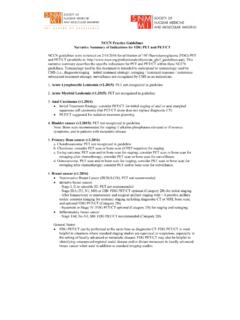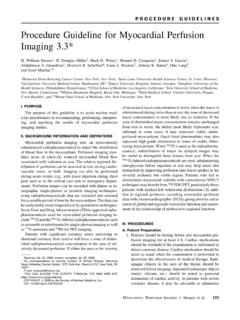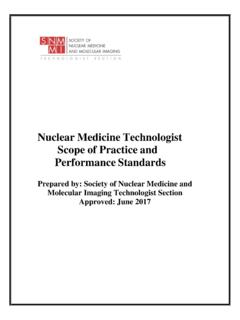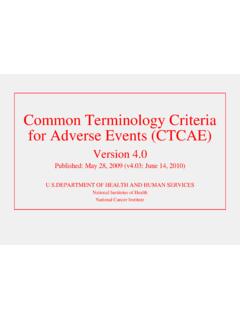Transcription of SNMMI/ASNC/SCCT Guideline for Cardiac SPECT/CT and …
1 SNMMI/ASNC/SCCT Guideline for Cardiac SPECT/CT and PET/CT *. Sharmila Dorbala1, Marcelo F. Di Carli1, Dominique Delbeke2, Suhny Abbara3, E. Gordon DePuey4, Vasken Dilsizian5, Joey Forrester2, Warren Janowitz6, Philipp A. Kaufmann7, John Mahmarian8, Stephen C. Moore1, Michael G. Stabin2, and Paul Shreve9. 1 Brigham and Women's Hospital, Boston, Massachusetts; 2 Vanderbilt University Medical Center, Nashville, Tennessee;. 3 Massachusetts General Hospital, Boston, Massachusetts; 4St. Luke's Roosevelt Hospital, New York, New York; 5 University of Maryland Medical Center, Baltimore, Maryland; 6 Baptist Hospital of Miami, Miami, Florida; 7 University Hospital Zurich, Zurich, Switzerland; 8 Methodist Hospital, Houston, Texas; and 9 Advanced Radiology Services, Grand Rapids, Michigan 8. Electrocardiogram (ECG) leads .. 7. INDEX 9. Position .. 7. Preamble .. 2 10. Breast feeding .. 7. I. Introduction .. 2 C. Information pertinent to the procedure.. 7. II. Goals.
2 2 1. History .. 7. III. Definitions .. 3 2. scan time .. 7. IV. Common clinical applications .. 3 3. Breath-hold .. 7. V. Qualifications and responsibilities of personnel 4. Informed consent .. 7. (in the United States) .. 3 D. Radiopharmaceuticals .. 7. A. Physicians .. 3 E. Acquisition protocols .. 7. 1. SPECT/CT Cardiac radionuclide 1. SPECT/CT MPI .. 7. imaging .. 3 2. PET/CT MPI .. 7. 2. PET/CT Cardiac radionuclide imaging.. 3 3. 18F-FDG PET/CT .. 8. 3. Cardiovascular stress testing .. 4 4. Attenuation-correction CT scan 4. Cardiac CT .. 4 (CTAC) .. 10. B. Technologists .. 4 5. Coronary artery calcium scan .. 11. 1. SPECT/CT Cardiac radionuclide 6. Coronary CTA .. 11. imaging .. 4 7. Fusion of radionuclide and CT images .. 13. 2. PET/CT Cardiac radionuclide imaging.. 4 F. Integrating diagnostic information from 3. Cardiac CT .. 4 radionuclide and CT images .. 13. C. Physicists .. 5 1. Coronary artery calcium scoring and D. The institution and equipment.
3 5 MPI .. 13. VI. Procedure/specifications of the examination .. 6 2. Coronary CTA and MPI .. 13. A. Patient screening.. 6 3. Indications and appropriate use B. Patient preparation and precautions .. 6 criteria for hybrid imaging .. 13. 1. NPO .. 6 4. Fusion of radionuclide and CT images .. 14. 2. Exercise.. 6 5. CTAC and emission images .. 14. 3. Caffeine.. 6 6. CTA and emission images .. 14. 4. Contrast allergy .. 6. VII. Documentation/reporting .. 14. 5. Intravenous access .. 6. VIII. Equipment specification .. 16. 6. Breathing instructions .. 6. IX. Quality control (QC) and improvement, safety, 7. Medications .. 6. infection control, and patient education concerns.. 16. Received Feb. 27, 2012; revision accepted Feb. 27, 2012. A. Hardware QC .. 16. For correspondence or reprints contact: Sharmila Dorbala, Brigham and B. Imaging QC .. 16. Women's Hospital, 70 Francis St., Boston, MA 02115. E-mail: 1. MPI .. 16. *NOTE: YOU CAN ACCESS THIS Guideline THROUGH THE snmmi 2.
4 CT .. 16. WEB SITE ( ). Published online Jun. 18, 2013. 3. Imaging QC unique to hybrid devices .. 16. COPYRIGHT 2013 by the Society of Nuclear Medicine and Molecular 4. Fusion software .. 16. Imaging, Inc. DOI: 5. Sources of error .. 17. Cardiac SPECT/CT AND PET/CT Dorbala et al. 1485. X. Radiation safety and ALARA issues .. 19 to treatment. Therefore, it should be recognized that adherence A. MPI dosimetry .. 19 to these guidelines will not ensure an accurate diagnosis or a B. MPI in the pregnant or potentially pregnant successful outcome. All that should be expected is that the patient .. 19 practitioner will follow a reasonable course of action based on C. MPI in the breast-feeding patient .. 19 current knowledge, available resources, and the needs of the patient to deliver effective and safe medical care. The sole purpose D. Coronary CTA.. 20. of these guidelines is to assist practitioners in achieving this XI. Conclusion.. 20. objective. XII. References.
5 20. XIII. Approval .. 23. I. INTRODUCTION. PREAMBLE. This Guideline was developed collaboratively by the snmmi . with the American Society of Nuclear Cardiology (ASNC) and the The Society of Nuclear Medicine and Molecular Imaging Society of Cardiovascular CT (SCCT). ( snmmi ) is an international scientific and professional organiza- Since 2002, there has been a rapid evolution of hybrid tion founded in 1954 to promote the science, technology, and imaging technology incorporating high-quality multidetector- practical application of nuclear medicine. Its 16,000 members are row CT technology, along with the latest SPECT and PET. physicians, technologists, and scientists specializing in the re- detector systems. The increasing clinical use of these hybrid search and practice of nuclear medicine. In addition to publishing systems for cardiovascular radionuclide studies necessitates the journals, newsletters, and books, the snmmi also sponsors establishment of guidelines to ensure reliable use and practice international meetings and workshops designed to increase the of this technology.
6 The purpose of this document is to assist competencies of nuclear medicine practitioners and to promote physicians in the proper performance (acquisition, processing, new advances in the science of nuclear medicine. interpretation, and reporting) of cardiovascular imaging proce- The snmmi will periodically define new guidelines for nuclear dures using hybrid-imaging devices and in the use of post- medicine practice to help advance the science of nuclear medicine processing software techniques to fuse cardiovascular images and to improve the quality of service to patients throughout the obtained on dedicated CT and radionuclide scanners. This United States. Existing practice guidelines will be reviewed for document assumes a basic knowledge of Cardiac SPECT (1 . revision or renewal, as appropriate, on their fifth anniversary or 5) and PET (1,4,6). For further details, the readers are referred sooner, if indicated. to the previously published Guideline documents.
7 The current Each practice Guideline , representing a policy statement by the document will focus on the use of hybrid imaging procedures snmmi , has undergone a thorough consensus process in which it and Cardiac CT. has been subjected to extensive review, requiring the approval of the Committee on guidelines and snmmi Board of Directors. The snmmi recognizes that the safe and effective use of diag- II. GOALS. nostic nuclear medicine imaging requires specific training, skills, Hybrid imaging is the term frequently used to describe imaging and techniques, as described in each document. Reproduction or approaches that combine radionuclide imaging with CT. This modification of the published practice Guideline by those entities could be achieved with both CT and radionuclide scanners not providing these services is not authorized. mounted on the same gantry or with separate imaging systems. These guidelines are an educational tool designed to assist The radionuclide component of hybrid imaging could include ei- practitioners in providing appropriate care for patients.
8 They are not inflexible rules or requirements of practice and are not ther SPECT or PET. The CT component of the original hybrid intended, nor should they be used, to establish a legal standard systems was designed primarily for attenuation correction and of care. For these reasons and those set forth below, the snmmi not for diagnostic anatomic imaging. However, the more recent cautions against the use of these guidelines in litigation in which SPECT/CT and PET/CT scanners incorporate multidetector CT. the clinical decisions of a practitioner are called into question. scanners that provide diagnostic-quality CT, including coronary The ultimate judgment regarding the propriety of any specific artery calcium scoring and coronary CT angiography (CTA). procedure or course of action must be made by the physician Hybrid SPECT/CT and PET/CT enable us to assess Cardiac or medical physicist in light of all the circumstances presented. physiology along with Cardiac and coronary anatomy (7 9).
9 The Thus, there is no implication that an approach differing from the use of CT-based transmission imaging and attenuation correction guidelines , standing alone, was below the standard of care. To the improves the diagnostic accuracy of myocardial perfusion imaging contrary, a conscientious practitioner may responsibly adopt a (MPI), compared with non attenuation-corrected MPI (10). Atten- course of action different from that set forth in the guidelines uation correction facilitates quantitative imaging of myocardial when, in the reasonable judgment of the practitioner, such course perfusion and metabolism. The assessment of anatomic coronary of action is indicated by the condition of the patient, limitations of atherosclerotic burden may amplify the diagnostic and prognostic available resources, or advances in knowledge or technology value of rest and stress MPI. Lastly, the fusion of Cardiac and subsequent to publication of the guidelines . coronary anatomy with functional imaging holds potential for re- The practice of medicine involves not only the science, but search applications in molecular imaging.
10 Data to support the also the art, of dealing with the prevention, diagnosis, alleviation, clinical utility of hybrid imaging continue to accrue (11). This and treatment of disease. The variety and complexity of human document provides a consensus recommendation for how best conditions make it impossible to always reach the most appro- to perform, interpret, and report clinical hybrid Cardiac imaging priate diagnosis or to predict with certainty a particular response studies. 1486 THE JOURNAL OF NUCLEAR MEDICINE Vol. 54 No. 8 August 2013. III. DEFINITIONS time to learn the physics and instrumentation of radionu- clide imaging, as well as training to perform and interpret A hybrid SPECT/CT scanner is an integrated device wherein radionuclide images and to understand radionuclide physi- the gantry includes both a SPECT scanner and a CT scanner, ology, radionuclide handling, and radiation safety for which use a common bed to move the patient sequentially through patients and personnel (14).

